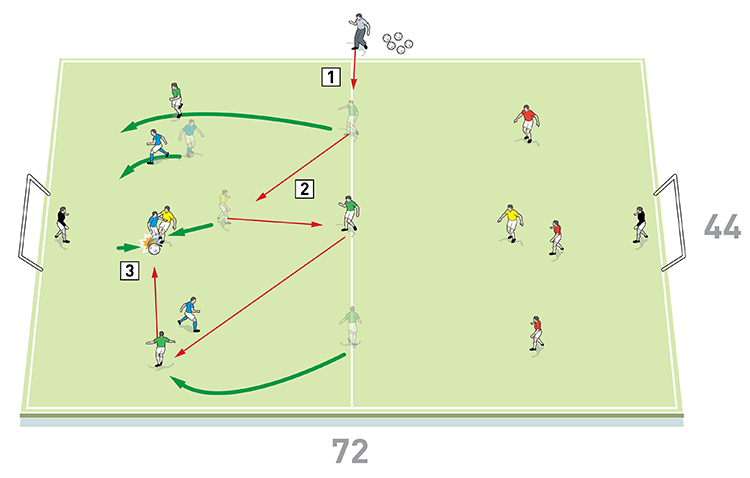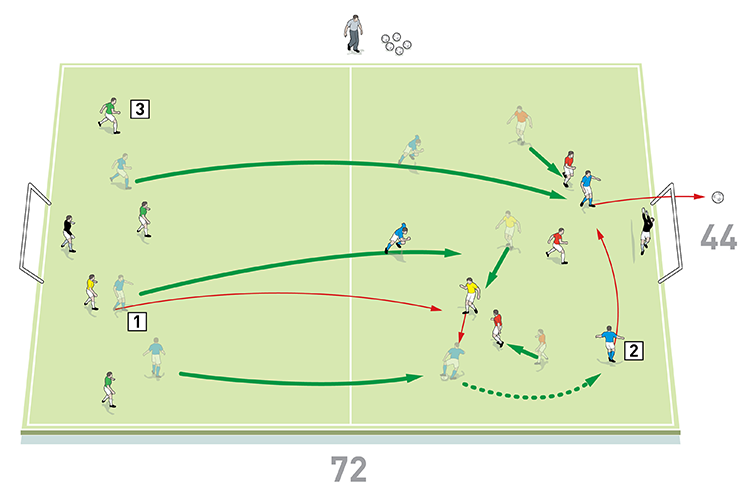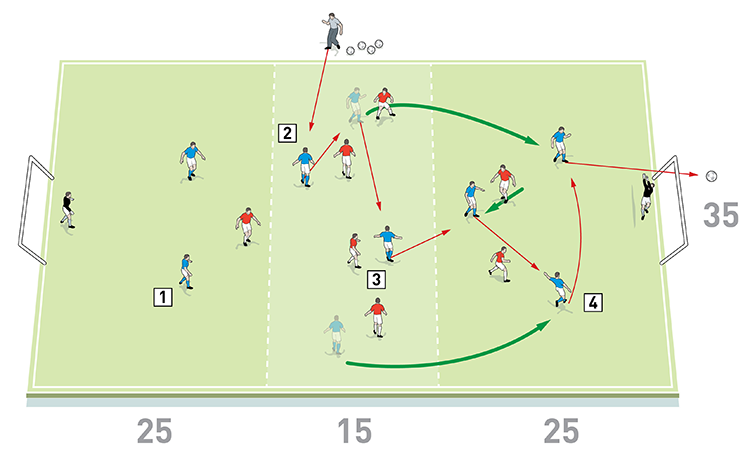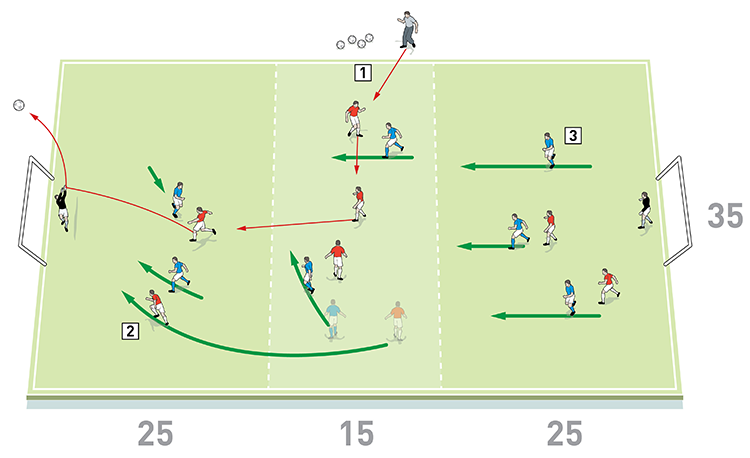You are viewing 1 of your 1 free articles
Quick counter-attacks
| Area | Up to 72x44 yards |
| Equipment | Balls, bibs, cones, 2 goals |
| No. of Players | Up to 14 players + 2 goalkeepers |
| Session Time |
Counter-attacking waves: 15mins Counter-attacking game: 15mins |
This session encourages fast break attacks and provides support with pace and balance to enable the attack to go from quickly to carefully if needed. The use of attacking overloading principles will be adopted into this practice, with the use of nearside movement (2v1s) and far side width (an ability to attack the weaker side). We will also look at decision making when the fast break no longer permits a counter-attacking phase.
The session is a wave-like practice. It has a high physical output and produces lots of transitional actions, which enables players to experience plenty of final third activity and end product. The practice can be progressed and can have a multitude of session objectives to enable the practice to be position-specific, unit-specific and allow us to coach our principles of play.
We would run this once every four weeks and we predominantly utilise it three days before a match. This is classed as a speed day for us in our periodized working week. The idea would be to expose players to high speed running for a physical perspective. It would also fit into an attacking themed day, from a technical and tactical perspective.
What do I get the players to do?
Counter-attacking waves
We set up an area of 72x44 yards with a goal and a goalkeeper at each end. We’re using 11 outfield players, split into three teams of three and two strikers. One team defends each half and the third team starts in the middle. One floating striker starts in each half, playing for the attacking team.
The team in the centre receives a starting pass from the coach and they attack one end, combining with the striker at that end to create a 4v3 overload, as shown [1a].
1a

2. The greens combine with the yellow striker at that end to create an attacking 4v3 overload
3. Here the blue defending team wins possession
If the opposition defenders win the ball, they counter-attack by passing to the striker at the opposite end and then they join him to attack that end, as shown [1b]. Teams then switch roles as play goes from end to end.
1b

2. The blues follow the ball and join the yellow striker to attack with a 4v3 overload
3. The greens now replace the blues as the defending team and wait for the next attack to come in their direction
Counter-attacking game
We set up an area of 65x35 yards with a goal and a goalkeeper at each end. The pitch is divided into 25-yard end zones and a 15-yard centre zone. We’re using 14 outfield players, split into two teams of eight including keepers. Each team starts with two defenders in their own end zone and a striker in the opposition’s end zone. The remaining players start in the centre zone.
We play an 8v8 directional game with a starting pass into the central zone by the coach. Players must stay in their zones until the ball gets to the end zone with a pass into the striker. Once the striker touches the ball, two midfielders from the possession team can move into the attacking zone, creating a 3v2 overload, as shown [2a].
2a

2. Play starts with a pass into the blue team in the central zone by the coach
3. Players stay in their zones until the ball gets to the end zone with a pass into the striker from midfield
4. Once the blue striker touches the ball, two blue midfielders can move into the attacking zone to create a 3v2 overload
As soon as the attack ends, either in a goal or with the ball going into touch, the coach plays another ball into the centre to the team that was defending and they attack the opposite end, as shown [2b]. With the two midfielders out of position from the previous attack, this makes the new move more like a counter-attack.
2b

2. The reds now attack the opposite end in the same manner, with a pass into the striker freeing up two midfielders to create an attacking overload
3. With the two blue midfielders out of position from the previous attack, this makes the new move more like a counter-attack
What are the key things to look for?
We want to see players making accurate release passes. We also want players to make quick supporting runs, performed with balance and tactical discipline. Near side movement is important to create attacking 2v1s and we want to see the use of far side width, with a player positioned to receive on the outside.
It’s a perfect session to see players demonstrating 1v1s, combination play, creative passes and clever movement to unlock and penetrate a defence.
What are the typical mistakes players might make and how do I avoid them?
There would be three common mistakes that players would typically make. Firstly, getting the detail and decision of the first pass wrong. Often because of the emotions of regaining possession and having an ability to initiate a counter-attack, players will force or hurry the first pass. This will often result in the pass lacking detail (such as the correct speed), or players always attempting to play in and off the forward as a priority. To overcome this, we position a player within 10 yards of the player regaining possession, so that they have a safe release pass.
Secondly, players can lack tactical positioning in the final third, making the same movements resulting in the attack becoming very narrow and without depth. To solve this, we link the final third to our attacking principles and our shape.
Thirdly, players can show a lack of understanding of when to go from quickly to carefully. Tactical disciple will solve this, as will a constant focus on attacking the weak side. The player who supports behind the ball is a key influencer in recognising when the ball should be recycled.
Related Files
Editor's Picks
Deep runs in the final third
Using the goalkeeper in build-up play
Pressing principles
Intensive boxes drill with goals
Penetrating the final third
Creating and finishing
My philosophy
Pressing initiation
Compact team movement
Coaches' Testimonials

Alan Pardew

Arsène Wenger

Brendan Rodgers

Carlos Carvalhal

José Mourinho

Jürgen Klopp

Pep Guardiola

Roy Hodgson

Sir Alex Ferguson

Steven Gerrard
Coaches' Testimonials

Gerald Kearney, Downtown Las Vegas Soccer Club

Paul Butler, Florida, USA

Rick Shields, Springboro, USA

Tony Green, Pierrefonds Titans, Quebec, Canada
Join the world's leading coaches and managers and discover for yourself one of the best kept secrets in coaching. No other training tool on the planet is written or read by the calibre of names you’ll find in Elite Soccer.
In a recent survey 92% of subscribers said Elite Soccer makes them more confident, 89% said it makes them a more effective coach and 91% said it makes them more inspired.
Get Monthly Inspiration
All the latest techniques and approaches
Since 2010 Elite Soccer has given subscribers exclusive insight into the training ground practices of the world’s best coaches. Published in partnership with the League Managers Association we have unparalleled access to the leading lights in the English leagues, as well as a host of international managers.
Elite Soccer exclusively features sessions written by the coaches themselves. There are no observed sessions and no sessions “in the style of”, just first-hand advice delivered direct to you from the coach.









